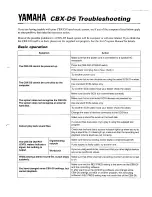
14
Section 1 - Safety Information
1.3 Nozzle Safety
Check Flow Rating
Combined nozzle flow rate must be compatible
with the pump discharge and pressure rating.
Refer to the nozzle flow chart in this manual.
Check Pressure Rating
Use only nozzles with a manufacturer’s pressure
rating of at least the pump’s operating pressure
or a burst rating of no less than 60,000 psi (4,137
BAR.)
Check Orifices
Prior to installation, make sure the nozzles have
no clogged orifices. Also, check to ensure nozzles
are sharp and not excessively worn.
Check Connections
Be sure to never force a nozzle into the blasting
head. Clean threads to ensure nozzle is not cross-
threading. Use an ample amount of anti-seize
on threads only, never on the seat of the nozzle.
Inspect the seat area on nozzle to ensure a tight
seal. If it is damaged, do not use.
Clogged Nozzles
If a nozzle appears clogged, immediately
disengage pump. Remove any clogged nozzles
and replace with new nozzles. Any particles of the
smallest size will clog nozzles. Clogged nozzles can
create excessive pressure in pump.
Remove Nozzle from Service if:
A) Nozzle is split or damaged.
B) Nozzle is clogged.
C) Nozzle water spray is fanned out.
D) Nozzle’s ability to hold pressure is suspect.
E) Nozzle’s hex head is worn excessively from
blasting.
F) Nozzle threads are damaged.
1.4 Hose Safety
General
Ultra-High Pressure hoses are tough, but not in-
vincible. They require proper care and handling
to achieve the normal service life of 300 - 600
hours. If the hoses are abused, the service life
will be much shorter.
Stretched or abused hose can fail prematurely
and unexpectedly, which could cause injury to
personnel. Hoses that have been exposed to
excessive stretching or kinks should be removed
from service and discarded.
Check Connections
Check the condition of the connection threads
prior to connecting any fittings or hoses. Use an
anti-seize compound on all fittings and hoses
to prevent “galling,” as galling will destroy the
threads, fittings and/or hose ends.
Tighten Connections
Properly tighten all high pressure connections.
Usually, snug plus a 15% tightening will properly
seal connections.
Take Proper Care of Your Hose
A) Protect the hose from contact with sharp
objects, abrasive surfaces and foot or wheel
traffic.
B) Never subject Ultra-High Pressure hose to a
tight radius (less than 30” (.8 m) or pull on a
coiled hose. Always make sure the hoses are
straight with no coils before pulling on the hose
to deploy it.
C) Never pull hard on an Ultra-High Pressure hose
or expose the hose to heavy loads like drag-
ging equipment or deploying long lengths of
hose. This can stretch the hose and weaken
it. Never pull more than 25 feet of hose by a
coupler or fitting. Always move long lengths
of hose by the hose itself to keep the strain
off the fittings.
D) When using a tractor or a hog tool, always op-
erate the equipment well within the maximum
distance to avoid straining or damaging hoses.
Check Burst Rating
Do not use an Ultra-High Pressure hose that does
not have a listed burst rating or with a burst rating
of less than 60,000 PSI (4,137 BAR).
Содержание SK5500
Страница 2: ......
Страница 80: ...80 NOTES...
Страница 135: ...135 Section 5 Scheduled Maintenance Hog Technologies...
Страница 141: ...141 Appendix 2 Tools Spare Parts...
Страница 142: ...142 Appendix 2 Tools Spare Parts...
Страница 143: ...143 Appendix 3 Daily Report Pre Op Checklist 1 877 HOG ROAD WWW STRIPEHOGSUPPORT COM...
Страница 151: ...151 Appendix 4 Spray Bar Nozzle Configuration 1 877 HOG ROAD WWW STRIPEHOGSUPPORT COM 68 Nozzle Calculation Sheet...
Страница 152: ...152 NOTES...
Страница 159: ......
Страница 160: ......















































